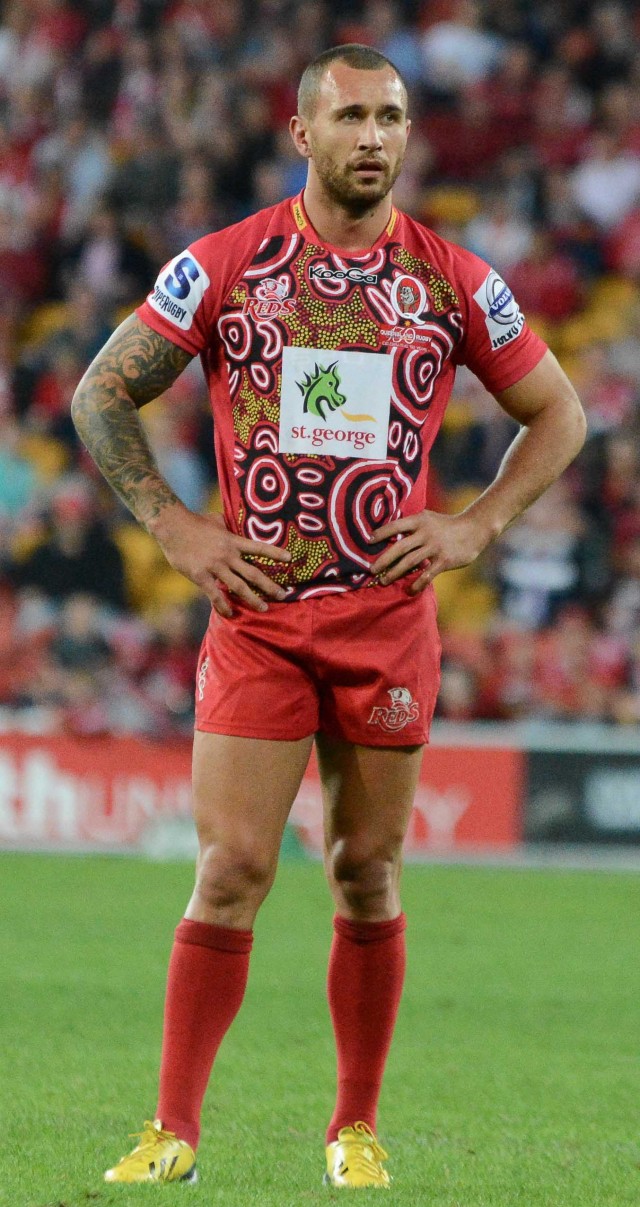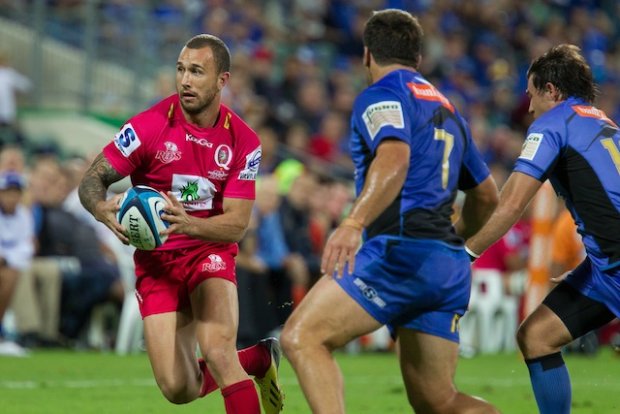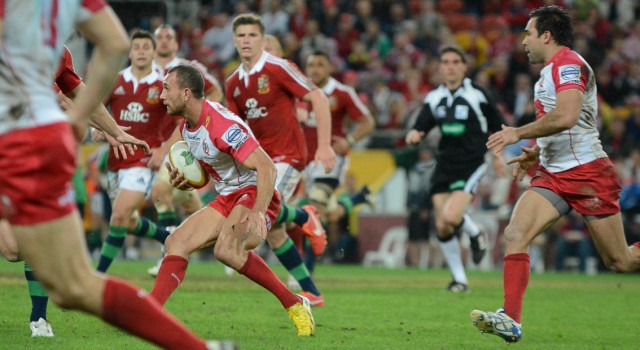Having assessed the promise of Matt Toomua in the first instalment of this three-part review of the pretenders to the Wallaby No. 10 jersey, it is none other than Quade Cooper in the spotlight today. After seeing James O’Connor struggle so visibly with his distribution against the Lions, the mere idea of Quade at No. 10 has a distinct appeal.
But is this an emotional response more than a rational one? Put it another way – when Quade’s game is broken down into its constituent parts, do they support the desire to see him at five-eighth?
The problem with Quade is no one thing; it is many things. He has too many identifiable (and identified) weaknesses and – crucially – it takes too much effort for a coach to construct a game plan that compensates for each one.
First, his defensive shortcomings are well documented, but this attention is fully merited. Anyone running at Quade knows they are going to “win” the contact – or have him fall off the tackle completely. This mash-up, from the 2010 Bledisloe Cup match in Hong Kong (which Australia ultimately won), underlines the point: even when Quade does make the tackle, the opponent still makes it well past the advantage line.
[youtube id=”GAbD4IlFefg” width=”600″ height=”350″]
Standing back, it is difficult to believe that a player has even played Test rugby at this level with such poor tackling skills. In Super Rugby this year, Cooper missed just under 30 per cent of all tackles attempted, while Toomua and Foley both miss 22 and 20 per cent respectively. If Quade were a defence force, he’d be New Zealand. Which is ironic, as if he had started playing rugby across the ditch I doubt he would have made it into a black jersey at all without some serious work on his skills in contact.
Traditionally, the Reds have sought to “hide” Quade away from front-line defensive duties, often at fullback. But Quade is very poor under the high ball, his second shortcoming. One wag commented during the Super Rugby season that Israel Folau is the only player in world rugby that when under a high ball, you don’t even think that he is going to drop it. Quade is the opposite.
Whenever he is targeted with an up and under, you find yourself holding your breath in the hope that he will catch it, before exhaling when he inevitably does not. If Cooper can be positioned away from high balls, this might just work: the table also shows that the Reds strategy of reducing how often Cooper has to tackle is effective.
 Another side-effect of removing Quade from the front line is that someone else has to fill in for him. In the Reds and the Wallabies, this has usually been Digby Ioane. This had the result of putting Ioane in close quarters, where he was indeed effective in both attack and defence. But he was rarely seen in the open space in which he can be so devastating.
Another side-effect of removing Quade from the front line is that someone else has to fill in for him. In the Reds and the Wallabies, this has usually been Digby Ioane. This had the result of putting Ioane in close quarters, where he was indeed effective in both attack and defence. But he was rarely seen in the open space in which he can be so devastating.
Without Ioane, who will take Quade’s place? Will James O’Connor play on the wing and be asked to defend at No. 10? Will Nick Cummins be asked to do the same? What if Jesse Mogg is the preferred fullback? Where exactly does that mean Quade is positioned when the All Blacks are on attack?
Put simply, Quade’s defensive frailties require a major reorganisation of the entire team’s defensive structure. This is a problem in and of itself. Why should one player require such drastic action? But what occurs if the other flyhalf in the Wallabies’ set-up, likely to be Toomua or even Bernard Foley, does not have these shortcomings? Does this mean that the entire positional structure of the team has to shift?
Defence and major problems under the high-ball are only two of Quade’s problems. Another is judgment. There is no doubt that Quade can do things that other players simply cannot. He can create openings and exploit weaknesses in the opposition’s defence that other flyhalves do not even perceive.
But his option taking has not matured since the 2011 World Cup debacle. He still does not understand that the merits of a low percentage, high yield play are a function of two factors: where you are on the field and how many points the play is likely to yield. The no look pass executed in the opposition’s 22, with a try beckoning if successful, is not an equally good option as the same pass executed in your own 22, with a line-break available if successful and a turnover of possession under pressure if not.
This principle was underlined in a different context by the Brumbies throughout this year’s campaign. They were often ready to flood rucks when in the opponent’s territory, knowing that a penalty in their favour meant three points while a penalty conceded likely meant only ceding 30 metres and an opportunity to contest the lineout. Points are sacred. Flair is optional.
Knowing when to throw that low-risk high-yield pass is a function of mature judgment. And little in Quade’s play this year has suggested that his game has matured. If anything, it has plateaued.
The table below illustrates this phenomenon. Certainly, the Reds of 2013 were not the Reds of 2011. But the point to stress is not that there were fewer tackles bust or linebreaks created in 2013 than in 2011 (though this is worth noting). It is the negatives: despite almost two years to work on his game, Cooper still makes just as many errors (which goes to his judgment and execution) and misses almost as many tackles (to his defence). The sharp drop in linebreaks created might be the result of being in a worse team, or being out of form. But the consistency of the errors and missed tackles points to an entrenched problem and one that is not going away.
Finally, there is the issue of Quade’s own personality. It seems strange that amid a backlash against the disregard for the jersey shown by Kurtley Beale and James O’Connor during the Lions series (and, let’s face it, long before that), there appears to be a sense that Quade was somehow a victim of the Deans’ era, not part of the problem.
Let’s clear this up: Quade’s off-field behaviour, including numerous appearances in court, has left a lot to be desired. Moreover, his outburst in late 2012 against a ‘toxic’ team culture evinced much the same “I’m bigger than the team” attitude that fans, players, and coaches seem to be currently united on eradicating.
Where does that leave us? The heart says that Quade Cooper can unlock the potential of Australian rugby, setting the team alight. I love watching Quade play.
The data and close analysis do not support this; rugby is played with shoulders, not hearts. They instead point to a player with numerous weaknesses, together requiring major adjustments to the team’s structure. This might work on a given day – indeed, mercurial as Quade is, it will work on a given day. But the whole team will need to be fashioned around an inflexible Quade-centric plan.
In the long term, if the Wallabies are serious about establishing themselves as a team that is hard to beat not just on their day but on any day they need a team, a game plan, and a structure that doesn’t have such gaping holes in its armour. They need a team so strong, balanced, and cohesive that in a World Cup injuries can force you to utilise your fourth choice flyhalf, as happened with the All Blacks in 2011, and he slots into the role. Cooper needs to fit into the team, not the other way around.
There are other options at No. 10. Why choose someone who misses nigh on 30 per cent of all tackles if you don’t have to? Right now, in the form Quade Cooper is in, it might be better for the Wallabies to go with someone else.
Who should have first crack at the Wallaby No. 10 jersey?
[poll id=”93″]



